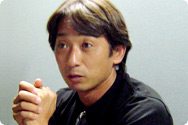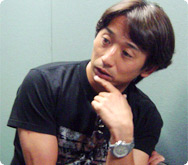The Battle of the Japanese GP is Already Underway
"The Japanese GP is, of course, a very special race for the Japanese. When I was driving, the cars still weren't what you could call really safe, so each time I came to the Japanese GP, I felt as if I'd made it home safely once again. Of course, it's a thrill to race in front of your home country fans, but there's also a lot of pressure. And I think this is a crucial test for Panasonic Toyota Racing. The engineers working on the chassis and engine have to produce real business results, so in that sense, I think they are under even more pressure than the drivers. In a sense, the Japanese GP is an unavoidable challenge on the one hand, and a very difficult place to perform on the other. The team has to uncover any unresolved issues before the Japanese GP, so in that sense, the battle has already begun in full gear."
The Secret to Fast Times
"For pure lap times, everything is determined between 1st Curve and S Curve. And the position at the exit of next Degner Curve is pretty much the same as the starting grid. But if you add extra downforce to have better grip through this section, then under race conditions, when you come out of 130R, you'll be at a speed disadvantage even if you are under full throttle, and you'll be overtaken pretty easily. Or when you come out of the chicane, the car behind yours gets into your slipstream and eventually you're overtaken on the following straight, which means you're unable to race competitively. So you have to make the detailed settings just so. In practice, you may decide your setups according to how much throttle you can put on through Dunlop Curve with tires that have ten or so laps on them."
Speed at the Exit of 130R is the Key
"When you're trying to overtake other cars during the race, the chicane is a really important section. What I mean to say is that you have 130R just before the chicane, so if you can create a speed advantage in 130R you have a chance to overtake through the chicane. For example, even if you're 5 km faster at full throttle on the straights, you still can't get by the car in front. But a 10 km or so differential out of 130R allows you to pull next to the car in front and fight for position. During qualifying, your speed coming out of 130R can mean a difference of 0.2 to 0.3 seconds. There is that much difference in the short straight out of the corner."
S Curve isn't a Curve Any More (!)
"I would say that S Curve is the other highlight of the circuit. The F1 cars of today have superb balance, so their turning performance is just awesome. With good front grip, these cars simply power in and out (of curves). So today, S Curve isn't really a 'curve' any more. With V8 engines, the cars are on full throttle more now, and I would bet that cars will be near full throttle (through S Curve) during qualifying. I think the drivers will take S Curve in 1, 2, 3, 4.brake lightly coming into Gyaku Bank, and be done. I think any F1 fan will be completely shocked through watching the race from this section. I think all of the drivers will elevate their game in that section this year. I think there will be some amazing action."
| |
 |
 |
You can't Drive Fast by Thinking too Much
"Sometimes your sense of sight isn't reliable-in fact, sometimes the vibration of the car makes it impossible to see the curve. At Suzuka in particular, there are some sections where the drivers will be screaming. If you concentrate on processing the information you see with your eyes, you'll lose the sense of the car's behavior that you can feel with your posterior, and that will cost you time. You need to feel your way into the corners, and then 'go quiet.' If you slip, you use your hands on the wheel to respond. Consciously thinking about each move takes the most time. You have to be in the same state of mind as when you wake up in the morning, and you automatically get ready for the day while you're still half-asleep. You have to lose pointless 'concerns' and 'doubts,' having complete confidence in your car and in yourself. Drivers have to be very stoic."
The World of F1: 150 Beats per Minute, and more than 4Gs of Physical Stress
"Under normal conditions, a driver's heart beats somewhere between 45 and 49 beats per minute. When the driver gets into the cockpit, beats per minute jump to about 60. Start the engine, and the driver's heart rises to 70 or 80 beats per minute, and then up to 100 during the formation lap as the driver starts to feel heavier G forces. And when the red starting lamps light up, the driver's pulse will jump to 150 or 160 beats per minute. During long curves, a driver will hold their breath through the entire time. Drivers hold their breath in the corners, and then finally start breathing again in the following straights. On top of all this, curves like 130R at Suzuka carry more than 4 Gs. When you're just standing still, you might not feel anything, but you're basically experiencing 1 G. Stand still like that for about 20 minutes, and you start to feel some weight. Driving 130R is four times that stress-being exerted sideways on top of that. That stress is repeated every few seconds for two hours straight. Normal folks would get stress fractures with that kind of intense force. It slowly hits your internal organs and joints like body blows from a boxer. Your eyeballs even start to push over to one side."
The TF106B has Podium-Winning Potential!
"As far as the TF106B is concerned, I think the car has improved a great deal. The only thing is that the results this season haven't matched the actual capabilities of the car. Jarno would be running 3rd in a race, and then experience a breakdown with only a few laps left. The car is actually much better than what you have seen. Of course, the other teams have also gotten stronger, so there are some tougher issues compared to last year, but the car itself has great potential."
"This year, Panasonic Toyota Racing has had a string of races that can only be described as unlucky. For example, the timing of the safety car at the Turkish Grand Prix completely fouled up their race strategy, and the team was within a hair's breadth of qualifying in the top 10 at the Italian Grand Prix. But still, you can only say that you had "bad luck" in so many races before you have to ask whether there's something else lacking. At that point, when you ask yourself what can be done, then the driver steps in. The driver can make up for a lack of tenths or hundredths of seconds. You see, motorsport might look like everything depends on the machinery, but that isn't quite so. The car's performance has come so close to the leaders now that I think a podium finish for Panasonic Toyota Racing at the Japanese Grand Prix would constitute a passing grade. The car's potential is not bad at all. I would like to see at least a third place finish for Panasonic Toyota Racing to show that their decisions this year haven't been wrong, and that they have not regressed compared to last year. Running third means being in a position with the potential to win the race if anything happens to the first and second cars. I think there is a special pressure on the team right now, but I would really like to see Panasonic Toyota Racing show its true capabilities."
|
